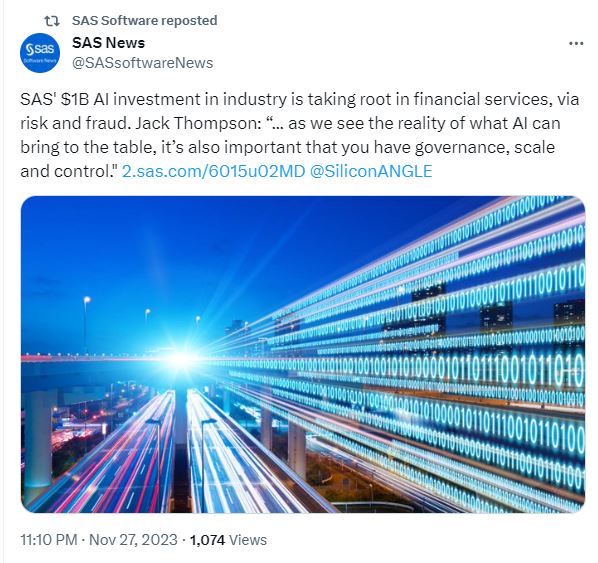
Will 2024 bring more challenges for CIOs? (Image generated by AI)
Shadow AI and tech debt: IT priorities for the next phase of digital transformation
- Shadow AI could be a major problem for CIOs in 2024.
- CIOs must have a data-first mindset.
- Given the opportunities and challenges of using AI and finops, CIOs also need to focus on technical debt.
CIOs around the world face different challenges, especially with the increasing adoption of technology by organizations. In 2023, there were two areas that dominated most discussions CIOs had with their boards. The first was on how much more budget businesses should allocate towards cybersecurity, and the second was on how much generative AI should the organization should be looking to implement – and what to expect in return for their AI investment.
Generative AI can be considered the biggest challenge for CIOs in 2023, simply because of the ways in which employees used the tool for work without proper guidelines and jurisdiction. Increased concerns about company data being exposed needed to be highlighted, with some organizations eventually banning or limiting the use of ChatGPT or similar generative AI tools at work.
According to Amir Sohrabi, regional vice president and head of digital transformation, emerging EMEA and Asia at SAS, generative AI has been an extraordinary leap forward for employee productivity, but it is also driving the use of tools that do not have the blessing of IT departments. IDC expects an increase in AI spending next year across the Asia Pacific, which means CIOs could be even more challenged in 2024.
“If this sounds familiar it’s because where CIOs previously struggled with “shadow IT,” today they need to account for “shadow AI” – the use of AI by a company’s employees that is unsanctioned by its IT department. Generative AI also requires significant guardrails so expecting CIOs to give in to unfettered adoption of these tools is out of the question,” said Sohrabi.

“As we see the reality of what AI can bring to the table, it’s also important that you have governance, scale and control.”
Shadow AI is a term that describes AI systems that are not officially known by or under the control of the IT department of an organization. It can happen when employees use or create AI applications without the approval or supervision of the IT department. This can pose various risks to the organization, such as data leakage, security breaches, model theft, or ethical issues.
Shadow AI can also hinder the coordination and integration of AI solutions across the organization, so IT leaders need to have clear policies and strategies to manage shadow AI and ensure its responsible and effective use.
Sohrabi believes that guardrails will still not stop employees from using tools like ChatGPT and Bard, which have enormous benefits for productivity. As such, CIOs in the region will need to grapple with this and study mitigation measures that are in line with their organization’s risk tolerance. Ultimately, well-intentioned employees will turn to these tools to be more efficient, and CIOs can ensure this doesn’t jeopardize the organization by proactively taking charge of the situation.

Shadow AI could be a big problem for CIOs in 2024. (Image generated by AI).
Levelling up data literacy and storytelling
“Immense technological change and the looming threat of a recession are driving businesses to look for new ways to operate more efficiently, while also increasing the ‘stickiness’ of their customers. The consensus among enterprises is that they need to make the most of technology to lower operating costs while maximizing efficiency and pursuing opportunities to grow the customer base,” explained Sohrabi.
As such, for CIOs to drive enhanced efficiencies and increased productivity, Sohrabi pointed out that they must have a data-first mindset. That’s because getting the most out of tools like generative AI hinges on having data in order – which entails good data management practices, including data access, hygiene and governance.
“Organizations that lack these best practices will find that generative AI isn’t as productive for them because it does not have accurate and well-managed data to act on. Good data management also improves customer experience, and facilitates innovation, while positioning the business to capitalize on cost-saving opportunities. Expect CIOs to take the reins to empower organization-wide data literacy,” he said.
At the same time, Sohrabi highlighted that as CIOs are integral to corporate strategy today, they need to get comfortable opening up to their C-suite peers and wider organizations about their challenges and wins. The reality of the situation is that a strong IT organization is now imperative because new technologies are being deployed on a near-daily basis.
“2024 will see CIOs lean into what they do best – using data and analytics to tell the story of the impact they’re having on corporate strategy. This will see CIOs detail how challenges were addressed through people, processes, and/or technology – which will also go a long way to building trusted relationships with colleagues throughout the enterprise,” Sohrabi said.

CIOs must have a data-first mindset. (Image generated by AI).
From Shadow AI to technical debt
While Shadow AI might be a concern, there are also some positives from businesses using more technology. However, as businesses migrate more of their digital infrastructure to the cloud, key questions around security, privacy, unauthorized usage, as well as access management and resource provisioning will continue to dominate.
“Expect this to have a major impact and drive the growth of financial operations (FinOps) as a means for businesses to reap the benefits of managed services from cloud service partners. At its core, FinOps is the practice of managing cloud spend by leveraging the inherent variability of cloud use. This is akin to turning off the lights at home when no one is using them. Failure to take advantage of this feature is akin to treating a public cloud as a very expensive data center.
Typically, technologies, services and infrastructure are always on in the average corporate data center. But just because IT departments are used to this model, doesn’t mean it should persist. With 2024 likely to be a year of opportunities and challenges in equal measure, expect businesses to take advantage of variable usage to enable significant savings,” said Sohrabi.
Given the opportunities and challenges of using AI and FinOps, there also needs to a be focus on technical debt. For example, as some development teams take shortcuts in writing code to achieve their goals faster, this can result in technical debt. When it accumulates, it can slow future development and cost more to rectify.
“Combating technical debt starts with robust continuous lifecycle management programs that categorize technology into understandable groups IT can act upon. However, reducing technical debt through lifecycle management is useless if more debt is added. That is why a committed enterprise architecture program to help map technologies to business processes sets the foundation for technology standardization. Expect CIOs to enforce adherence to enterprise architecture target states and technology standards,” added Sohrabi.
Sohrabi believes that 2024 will definitely be a year of significant challenges. But he also believes that there will be opportunities, especially for businesses that are quick to the punch and able to withstand disruption.
“CIOs will be critical to this, as they can make a difference by leading the integration of new, emerging technologies and trends with business strategy. This will be crucial for driving businesses to refine operating models that enhance business operations and provide products and services which engender customer loyalty, for business advantage in an ever more competitive landscape,” he concluded.
What does the future hold? Let’s see what could be on the horizon in the next iteration of artificial intelligence. Here are 12 predictions from SAS 💭 . https://t.co/UPm8X54FFX #AIpredictions #SASpredictionsAI pic.twitter.com/GGzu2JBZfv
— SAS Software (@SASsoftware) November 30, 2023
READ MORE
- Safer Automation: How Sophic and Firmus Succeeded in Malaysia with MDEC’s Support
- Privilege granted, not gained: Intelligent authorization for enhanced infrastructure productivity
- Low-Code produces the Proof-of-Possibilities
- New Wearables Enable Staff to Work Faster and Safer
- Experts weigh in on Oracle’s departure from adland






